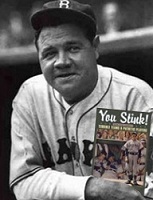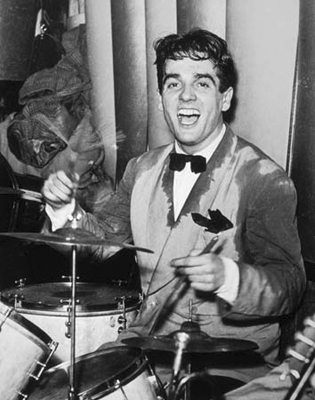A look at the king of percussion…and perspiration. By Michael Aubrecht, co-author of FUNdamentals of Drumming for Kids (w/ Rich Redmond)
In the dictionary of slang, the expression "by the sweat of his brow" is used to describe the route whereby an individual's hard work and diligence are rewarded. In a culture that was founded on the premise that one earns his keep, sweat, in American ideology, represents a physical manifestation of the price that one pays for expending exceptional effort while achieving success. Sweat therefore equates to an element of a performance worthy of our respect.
Naturally, one would assume that "sweat" is a suitable noun to be used when praising the efforts of an athlete on the playing field, but what about those of a musician on stage? Does the sweat resulting from the physical activity of playing music under the lights necessitate the same type of commendation as playing a sport? Obviously musicians perspire, but is that a notable measure when discussing their appeal as performers?
According to the legacy of one legendary musician, the answer is a resounding yes.
That musician is none other than the big band maestro Gene Krupa, who is considered by both drummers and non-drummers alike to be one of the greatest virtuoso performers ever to top the bandstand. Like myself, prior to penning this piece, most folks are probably unaware of the fact that sweat has played a prominent part in the legacy of "The Ace Drummer Man."
As a drummer, historian and Krupa devotee, I have spent many hours with my nose buried in yellowed newspaper articles, reading dusty eye-witness accounts and faded press packages that examined the impact of this amazing drummer, not just on music, but also on the popular culture of the 1930's and ‘40's. Surprisingly, the common description that keeps coming up again and again when reading about the life of Gene Krupa is "sweat."
In fact, from what I can interpret, perspiration appears to be more prevalent in Gene Krupa conversations than that of any other musician of his era. It is as if the raw physicality of Krupa's performance was, and is, just as revered as the musicality of it, and that is what makes the "sweat of Krupa's brow" particularly fascinating.
Back in the day, musicians of Krupa's caliber often published press manuals that were provided to potential promoters in advance of bookings. As predecessors to today's media kits, these instructional guides outlined everything from a musician's background and personal tastes, to their specific stage set-ups and equipment requirements. They also included a series of press-ready article templates that could be filled in and used for event promotion.
Gene Krupa's official MCA press manual from the late 1930's was titled "The Ace Drummer Man, Gene Krupa and his Orchestra: Publicity-Advertising-Exploitation." On page 12, there is a very peculiar template titled "Changes Clothes Often."
It states: Gene Krupa, drummer-bandleader, who is scheduled to appear at ____ on ____, through arrangements with Music Corporation of America, drums so strenuously that he needs an entire change of clothes at every performance. He carries a wardrobe of more than thirty suits which, although specially waterproofed, must be changed after each stage show or forty-five minute jam session. Despite the terrific pace Krupa's supply of energy is inexhaustible, for he never tires of his drums. At a recent theater appearance the maestro-drummer made thirty-five changes of clothes during the week, five changes a day.
This is the first time, in my research, that massive perspiration, necessitating multiple wardrobe changes, was used as a marketing tool for a jazz performer. Two other sections of the manual reinforce the apparent brutal toll of Krupa's drumming. The first piece, titled "Drummer vs. Athlete" correlates Krupa's musical performance to that of a sporting contest:
"When it comes to beating the drums, Gene Krupa, is generally considered to be the fastest man in the business, and according to health authorities, he expends as much energy in working as do athletes in pursuing strenuous sports." It adds that: "James Davies, health and exercise authority measured Krupa's exertion during a ‘jam session' and declared his drumming required as much energy as almost any other human motion. Davies compared the drumming with a five-minute handball game at top speed, a 14-foot pole vault, a six-foot high jump or a 24-foot broad jump. Two swing numbers in a row as Krupa plays them are more enervating than a mile run or four line plunges on a football field."
The next section in the narrative is titled "Loses Weight Nightly" and states: "Medical authorities have explained the phenomena of Gene Krupa, world's greatest drummer, who never tires during his workout, although he almost ends his nightly dance sessions in total collapse, by explaining that his physical system in now hardened to this serious strain - and is put back in shape by the five hearty meals which the drummer eats daily."
Looking at this analysis strictly in terms of swing-drumming, one can only imagine the physical exertion that speed-metal drummers of the modern era are expending over the course of a show. That in itself makes Krupa's skill set even more delicate as the style of music he perfected required much more diversity and finesse than that of a thrasher.
At the time of this publication though, there was no speed-metal. Popular music, more specifically swing music, wasn't gauged by the physical requirement of the arrangements. It was gauged by the intensity experienced by the audience while dancing to it. The taxing efforts put forth by the musicians performing it went relatively unnoticed - except when discussing Gene Krupa.
My point is that I've never read an article about Dave Lombardo that compares him to Olympic sprinter Usain Bolt; nor do I believe that Slayer's press kit specifically uses as a ticket teaser, the buckets of sweat that Lombardo produces while performing. The sweat that is most notably recalled at a Slayer concert is spent in the pit, by the crowd.
So what was it about the ferocity-induced sweat of a Gene Krupa performance that stood out so significantly that it became symbolic of his exceptional efforts? And why was this so unusual during his era?
No doubt anyone who witnessed Krupa laying down tribal beats on such hits as "Drum Boogie" and "Sing Sing Sing" would agree that his stamina was remarkable. In his book The World of Gene Krupa: That Legendary Drummin' Man, Bruce H. Klauber showcases the percussionist's epic perspiration as an example of the intensity of his playing. He writes, "Krupa made a visual impact, what with his...sweating...with hair flying and sticks twirling all the while under the light strobe."
In a 2003 Joe Levinson article titled Benny and Gene! Together Again! musician Dave Frishberg recalled how Krupa's energy didn't stop once he left the bandstand, even when he was soaked to the bone and obviously spent:
"Gene stood behind the bar and signed every damned picture," he writes, "He even signed special requests: ‘Can you write "To Sidney from Gene Krupa? Would you dedicate it ‘To Mary from Gene Krupa'? Make it to my granddaughter: ‘To Gwendolyn from Gene Krupa.' Gene was a real gentleman. He autographed every picture standing, sweating, tired, and holding back his anger."
The only conclusion that I can draw from all of this is that Krupa was the first, and more importantly, the best sweater on the bandstand - meaning that he performed at a level that eclipsed the efforts of his peers, as indicated by his sweat. In fact, Krupa sweated so much that it literally became his calling card.
This evidence inevitably proves that the energy expended when drumming can equal that expended in a sport. Gene Krupa was absolutely an athlete in terms of physical exertion, and he obviously excelled in his field. Most impressive is the fact that Krupa's physical flair did not overshadow, but ultimately accented his brilliant musicianship.
And that is what made Gene Krupa's sweat more significant and noteworthy than anyone outside of the music scene could probably comprehend. If respect can be measured by sweat, then it's fair to say that Gene Krupa sweated...a lot. Best of all, he earned every drop of that sweat, every time he sat behind the drum kit.
 2012-2013 Amazon Best-Seller: Top 100 ‘Baseball’ and Top 10 ‘Baseball Statistics’ categories. Now available in both Paperback Edition and improved Kindle Edition
2012-2013 Amazon Best-Seller: Top 100 ‘Baseball’ and Top 10 ‘Baseball Statistics’ categories. Now available in both Paperback Edition and improved Kindle Edition 






 I’m very proud to announce that I will be a new contributing writer for the exceptional publication
I’m very proud to announce that I will be a new contributing writer for the exceptional publication 